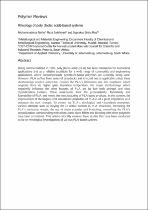JavaScript is disabled for your browser. Some features of this site may not work without it.
- ResearchSpace
- →
- Research Publications/Outputs
- →
- Journal Articles
- →
- View Item
| dc.contributor.author |
Nofar, M

|
|
| dc.contributor.author |
Salehiyan, Reza

|
|
| dc.contributor.author |
Ray, Suprakas S

|
|
| dc.date.accessioned | 2019-07-30T07:02:47Z | |
| dc.date.available | 2019-07-30T07:02:47Z | |
| dc.date.issued | 2019-03 | |
| dc.identifier.citation | Mohammadreza Nofar, Reza Salehiyan & Suprakas Sinha Ray (2019): Rheology of poly (lactic acid)-based systems, Polymer Reviews, DOI: 10.1080/15583724.2019.1572185 | en_US |
| dc.identifier.issn | 1558-3724 | |
| dc.identifier.issn | 1558-3716 | |
| dc.identifier.uri | https://doi.org/10.1080/15583724.2019.1572185 | |
| dc.identifier.uri | https://www.tandfonline.com/doi/full/10.1080/15583724.2019.1572185 | |
| dc.identifier.uri | http://hdl.handle.net/10204/11056 | |
| dc.description | Copyright: 2019 Taylor & Francis. Due to copyright restrictions, the attached PDF file only contains the abstract of the full-text item. For access to the full-text item, kindly consult the publisher's website. The definitive version of the work is published in Polymer Reviews, DOI: 10.1080/15583724.2019.1572185 | en_US |
| dc.description.abstract | Being commercialized in 1992, poly (lactic acid) (PLA) has been considered for biomedical applications and as a reliable substitute for a wide range of commodity and engineering applications where noncompostable petroleum-based polymers are currently being used. However, PLA suffers from series of drawbacks and it would not be applicable unless these shortcomings resolve somewhat. Besides the PLA’s brittleness and low toughness which originate from its higher glass transition temperature, the major shortcomings which negatively influence the other features of PLA are its low melt strength and slow crystallization kinetics. These weaknesses limit the processability, formability and foamability of PLA, and hence, the manufacturing of PLA based products. In this context, the improvement of rheological and viscoelastic properties of PLA is of a great importance as it enhances the melt strength. To control the PLA’s rheological and viscoelastic properties, various attempts such as varying the D-lactide content in PLA molecules, increasing the PLA’s molecular weight, the use of chain extender and branching, controlling the PLA’s crystallization, compounding with micro-/nano-sized fillers and blending with other polymers have been considered. This article critically reviews these studies that have been conducted so far on rheological investigations of various PLA-based systems. | en_US |
| dc.language.iso | en | en_US |
| dc.publisher | Taylor & Francis | en_US |
| dc.relation.ispartofseries | Workflow;22377 | |
| dc.subject | Blend | en_US |
| dc.subject | Degradation | en_US |
| dc.subject | Foam | en_US |
| dc.subject | Nanocomposite | en_US |
| dc.subject | Polylactide | en_US |
| dc.subject | Poly (lactic acid) | en_US |
| dc.subject | Rheology | en_US |
| dc.subject | Viscosity | en_US |
| dc.subject | Viscoelastic properties | en_US |
| dc.title | Rheology of poly (lactic acid)-based systems | en_US |
| dc.type | Article | en_US |
| dc.identifier.apacitation | Nofar, M., Salehiyan, R., & Ray, S. S. (2019). Rheology of poly (lactic acid)-based systems. http://hdl.handle.net/10204/11056 | en_ZA |
| dc.identifier.chicagocitation | Nofar, M, Reza Salehiyan, and Suprakas S Ray "Rheology of poly (lactic acid)-based systems." (2019) http://hdl.handle.net/10204/11056 | en_ZA |
| dc.identifier.vancouvercitation | Nofar M, Salehiyan R, Ray SS. Rheology of poly (lactic acid)-based systems. 2019; http://hdl.handle.net/10204/11056. | en_ZA |
| dc.identifier.ris | TY - Article AU - Nofar, M AU - Salehiyan, Reza AU - Ray, Suprakas S AB - Being commercialized in 1992, poly (lactic acid) (PLA) has been considered for biomedical applications and as a reliable substitute for a wide range of commodity and engineering applications where noncompostable petroleum-based polymers are currently being used. However, PLA suffers from series of drawbacks and it would not be applicable unless these shortcomings resolve somewhat. Besides the PLA’s brittleness and low toughness which originate from its higher glass transition temperature, the major shortcomings which negatively influence the other features of PLA are its low melt strength and slow crystallization kinetics. These weaknesses limit the processability, formability and foamability of PLA, and hence, the manufacturing of PLA based products. In this context, the improvement of rheological and viscoelastic properties of PLA is of a great importance as it enhances the melt strength. To control the PLA’s rheological and viscoelastic properties, various attempts such as varying the D-lactide content in PLA molecules, increasing the PLA’s molecular weight, the use of chain extender and branching, controlling the PLA’s crystallization, compounding with micro-/nano-sized fillers and blending with other polymers have been considered. This article critically reviews these studies that have been conducted so far on rheological investigations of various PLA-based systems. DA - 2019-03 DB - ResearchSpace DP - CSIR KW - Blend KW - Degradation KW - Foam KW - Nanocomposite KW - Polylactide KW - Poly (lactic acid) KW - Rheology KW - Viscosity KW - Viscoelastic properties LK - https://researchspace.csir.co.za PY - 2019 SM - 1558-3724 SM - 1558-3716 T1 - Rheology of poly (lactic acid)-based systems TI - Rheology of poly (lactic acid)-based systems UR - http://hdl.handle.net/10204/11056 ER - | en_ZA |






